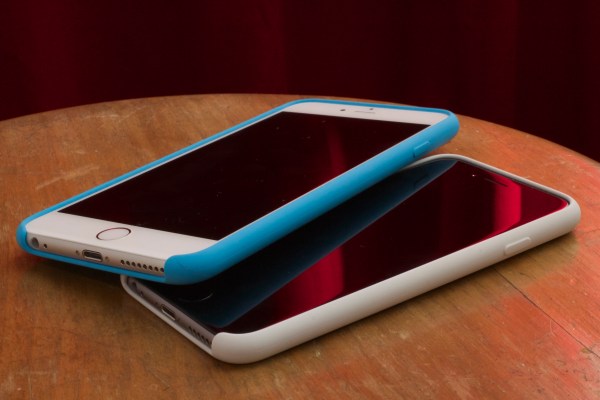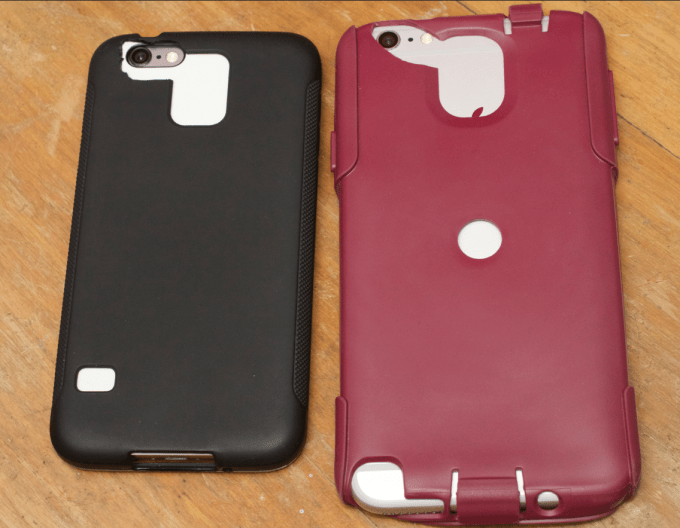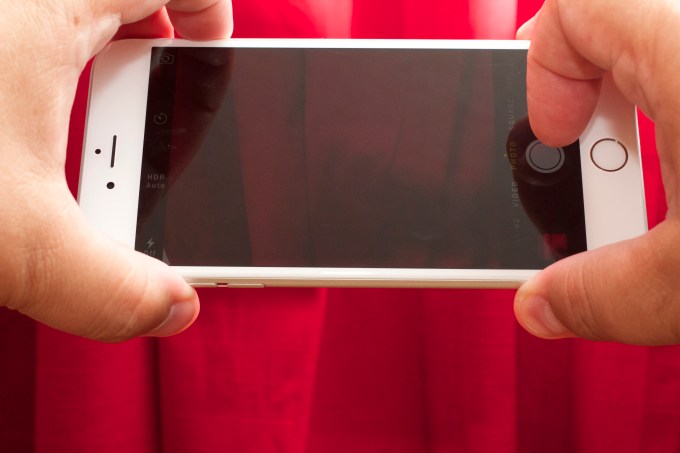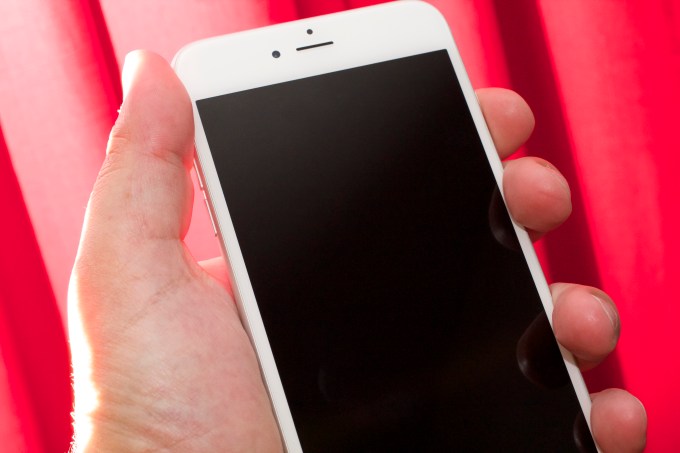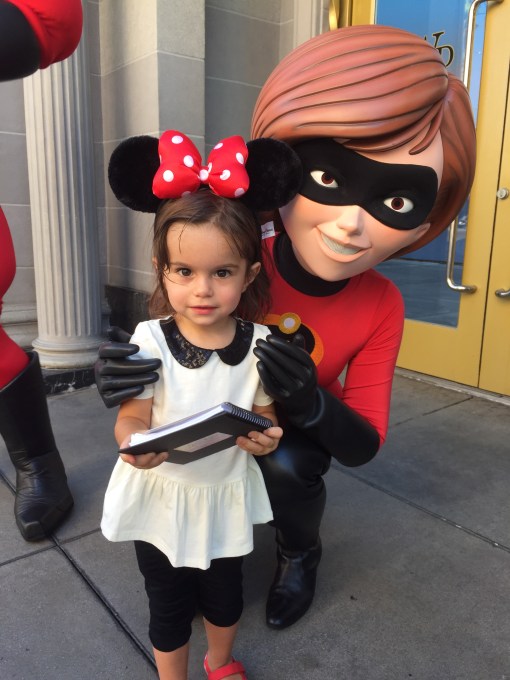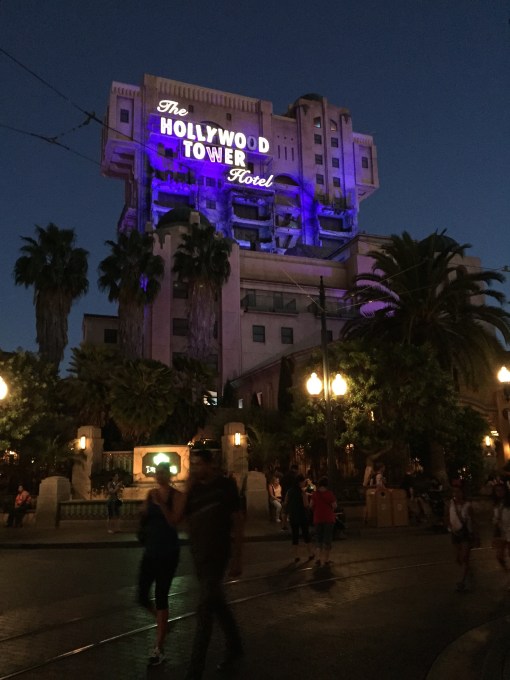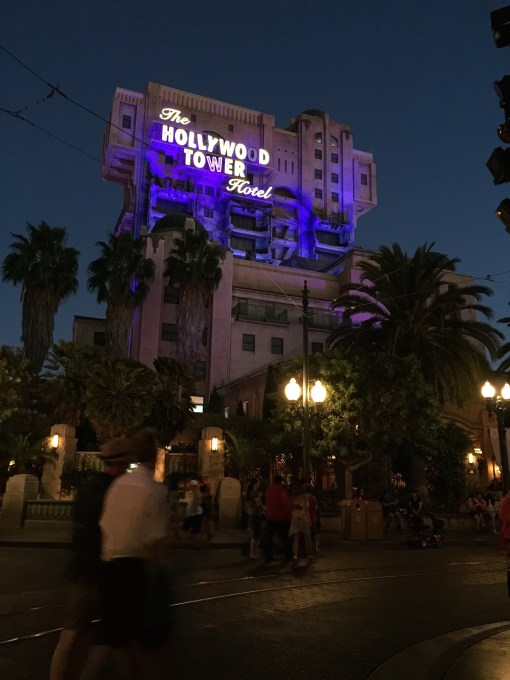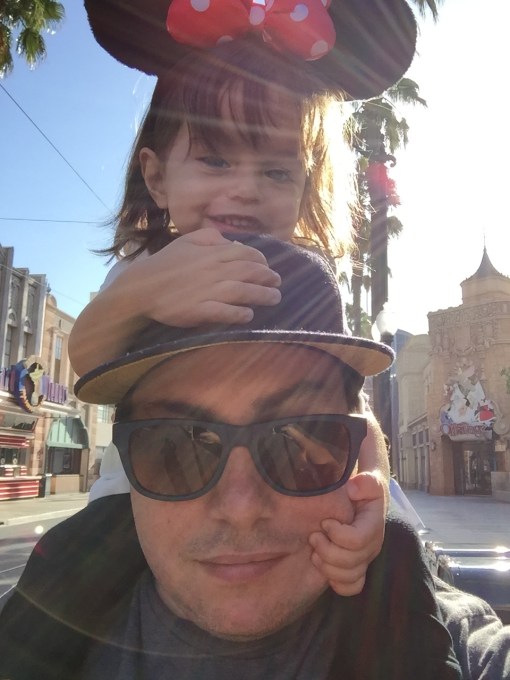Last week I decided to test the most secretive, hotly anticipated smartphones on earth in a place where there was no danger of them being recognized or damaged or both: Disneyland.
Both my wife and I are Disneyphiles of sorts, and visit a dozen times a year or more. I have an appreciation for it because my daughter loves to go, but also because of how carefully the place is planned, constructed and run. Disneyland is the Apple of theme parks. What better place to test the new models?
I’ve had a ton of experience using phones to navigate, communicate and photograph in the park. It’s tens of thousands of people packed into the same square mile, all using devices to do the exact same thing you are. The network is crushed, it’s bright and hot and you’re juggling kids and strollers and other vacationers. It’s an ideal real-world test for smartphone batteries, screens, usability and cameras.
There are a ton of reviews out there that have done meticulous work with benchmark apps, rulers and rectal thermometers to get you spec-based evaluations of the new iPhones. This is not one of them. I took a trip and used the junk out of them. I had some interesting realizations, I took some good pictures and I wasted some time in long lines playing Spider-Man. If this sounds like what you do on trips then you could find something useful here.
Aside from any Apple employees who may have visited the park, I believe I’m the first to have ever used the new iPhones there. So here’s my Disneyland take on the iPhone 6 and iPhone 6 Plus.
Because I drove home from TechCrunch Disrupt and drove to Southern California on the same day, I had no time to prepare the iPhones for the trip — especially how I was going to disguise them so I didn’t out them before the review date. So, after a quick consultation with some spec comparison charts for dimensions, I stopped at Best Buy on the way and chose a half-dozen different Samsung Galaxy S and Galaxy Note cases to try. When I got to the hotel I tried a few out until I found a couple that worked and cut holes in the backs for the iPhone’s camera, which is in the corner.
These are my super stealthy iPhone 6 disguises:
The Galaxy Note III is significantly shorter (!) than the iPhone 6 Plus, so the case fit pretty poorly, but it did the job.
Forgive the cutting job but I had to borrow scissors from the hotel desk and they don’t let you take them away for some reason — probably fear of mattress tag cutting. So I quickly and nervously eyeballed my camera holes as the bellman managed the trick of furrowing his brows at me while still smiling politely and wondering what in Odin’s Beard I was doing to my phone cases.
They’d fool no one who was really looking, but they were enough to obscure the outlines enough to not warrant that second glance.
No one ever noticed, and even though I was with 10 family members none of them ever noticed that I was using the new stuff — though they’re used to me juggling my Nexus 5, Windows Phones and iPhones in the process of staying current.
Monsters Inc. Power Co.
The battery life situation is always a sticky one in the parks. Because there is no WiFi, everyone fights for a slice of the cellular spectrum to upload Instagram pics, browse the web in line and watch Apple keynote videos.
I used the iPhone 6 Plus for two days straight at Disneyland without charging it once and still had 16% battery life left. The iPhone 6 did very well too, with 32% left after a single day of use, but the 6 Plus was definitely a beast. 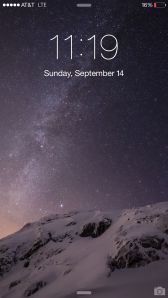
Remember that (as with everything else in this piece) I didn’t ‘stress test’ the battery, I just used the phones heavily. This included things like loading up the line wait times for a ride or messaging pictures I took to family members who wanted them. Lots of texting, sharing locations and calling to triangulate where everyone was. And a significant amount of gaming, both 3D and puzzle, to pass the time in lines.
So your mileage may vary, but there’s a significant difference between the two in this regard.
Guest Services
The iPhone 6 is more comfortable, by far, to use for messaging and for photos. I’ve handled all kinds of cameras over the years and the 6 Plus has to be one of the more awkward. It’s just fine in vertical mode but horizontal becomes a choice from awkward finger reach to the shutter button or a sideways press on the volume button situated on a slippery curve to shoot.
Moving the sleep buttons to the sides of the phones was a great decision. My Nexus 5 has the same configuration and it makes a lot of sense. When applying pressure to it you have a guaranteed diametrically opposed force from your thumb on the other side of the phone to make it a sure proposition to press. With the button on the top you’re pressing down against nothing, forcing you to ’squeeze’ the phone overall, which is more awkward.
The new sleep/wake position pays when you’re blazing hot and sweaty and handling a bare iPhone. It’s better with a case but the more slippery designs of the new iPhones are a consideration and make handling the 6 Plus iffy sans protection. I’d love an additional shutter button, like the Nokia 1020, but doubt that’s happening any time soon.
Main Street Photo Supply
The iPhone 6 is easier to handle and performed extremely well in all lighting conditions. The low-light performance is nearly identical between the two models, even though only the 6 Plus has OIS (optical image stabilization).
Both cameras shot well in good light, with great performance in super bright sun. Especially welcome were their ability to capture even bright reds like Mrs. Incredible’s costume (shot with iPhone 6):
Solid, bright reds are notoriously difficult for image sensors to capture but both iPhones handled them well.
Apple has made significant improvements to its ISP (Image Signal Processor) which have resulted in apparent gains in sharpness, color rendition and low-light performance. The iPhone 6 and iPhone 6 Plus are the best smartphone cameras I’ve ever used, and approach the best point-and-shoot cameras I’ve ever shot.
Cameras like the one in the Nokia 1020 may have more raw resolution, but Apple’s decision to build its own ISP, and to fine-tune it to the sensors and hardware it is using has paid off big time. A lot of attention gets paid to Apple’s chip efforts on the A-series processors, but the ‘sidecar’ chips like the custom ISP and M8 are just as important — and just as good a reason for its competitors to step up and start designing their own stuff. The results are palpable.
You’ll also be happy to know that there didn’t appear to be any purple fringing issues in highlight areas with either camera.
The phase detection autofocus is extremely quick, and the continuous autofocus while video recording is active is absolutely fantastic. The leap in quality over even dedicated cameras can’t be overstated. The image quality is off the charts and the (software driven) “Cinematic Stabilization” is amazing. With some apologies for the asynchronicity, Here’s a video shot with the iPhone 6 on the Big Thunder Mountain Railroad split-screened with one I shot just a couple of years ago with a point-and-shoot:
Note the shakiness of the dedicated camera, and how quickly the iPhone 6 transitions from dark to light. The cinematic stabilization is wildly effective at evening out what you can see was actually a very bumpy ride.
The focus, too, makes the iPhone version of the video that much better. And then realize that this was down sampled to 720p to match the older video. The iPhone 6 shoots in 1080p, making it even crisper.
Tower Of Optical Terror
There are technical reasons why OIS isn’t all that effective in point-and-shoot cameras but the simple explanation is that the devices are low-mass, the lens is tiny and so is the amount of ‘throw’ that it has to move back and forth to counter your hand motions. Will it help? Absolutely. Will you notice? Probably not a lot.
Here are a couple of images taken with the iPhone 6 and iPhone 6 Plus at night in ideal ‘stabilization would help here’ conditions:
The results are great, no matter which you shoot with. I was consistently blown away with the low-light performance of both models. Technically speaking the OIS “gives you back” around 3 stops of light, letting you shoot at slower shutter speeds with decent quality. That’s great, but is applicable to a small slice of your overall shooting. Still subjects while you’re also relatively still at night or at dusk. It won’t help you with moving subjects at all, something that Apple has tried to fix by combining long and short exposures (a new trick) together to create a sharper image. That works on both models.
Here are a couple more images that show off the light-gathering abilities of the iPhone 6 and iPhone 6 Plus:
Yep, the iPhone 6 Plus image above is ‘better’, but probably not enough for most people to notice without a direct comparison. For those of you feeling existential angst over the OIS in the iPhone 6 Plus, don’t stress. Buy it for the screen, buy it for the battery, but don’t buy it for OIS.
Unless, of course, you’re a photographer that wants every last pico of quality out of the camera and you’re ok with the size.
Even in brutally unfair lighting conditions, like the inside of a dark ride, the iPhone 6 performed well:
The selfie camera got a great upgrade, too. It’s sharper and better in crappy light, though it still has a bit of an ‘interpolated’ watercolor-ey feel. I use FaceTime a lot when I’m traveling and the poor quality has always bothered me. It’s not mind-blowing but it’s good to see Apple paying attention to the trends.
As a side note: Apple’s decision to eliminate the camera roll and to merge photos from various devices using the same Apple ID is going to confuse a lot of people. I’m not sure it’s the right choice and was confused by it multiple times and I’m paid to get this stuff.
The screens of both the iPhone 6 Plus and iPhone 6 are top notch. Color rendition is accurate and vibrant. Both are visibly sharper than the iPhone 5S on even casual inspection and the iPhone 6 Plus has one of the best, if not the best, screen I’ve ever used on a smartphone.
Which One Is The Wildest Ride In The Wilderness?
I had decided early on to use each device for a couple of days straight to get a feel for how they’d work, and then carry both in my pockets to see which one I naturally reached for. This period turned out to be fairly revealing.
When I wanted to browse the web, play a game, read anything of any real length or (and I think this is most important) watch a video, I reached for the iPhone 6 Plus. If I wanted to shoot a photo or message someone, check Instagram or my fantasy football scores I grabbed the iPhone 6. This leads me to believe that the iPhone 6 Plus will be very big wherever people use their phones in a ‘tablet’ fashion.
The iPhone 6 Plus is a great option for people who don’t have or want an iPad — or simply don’t want to carry it. Where the iPhone 6 is a great upgrade to the iPhone line, the iPhone 6 Plus is a fantastic ‘computer’.
I would feel much more comfortable typing out blog posts quickly or proofing articles with the larger iPhone. The iPhone 6 Plus is a great mobile command center for work uses, and I think that its adoption will spell that out.
I’d also keep an eye on areas of the world where video watching is often done on tablets over even TVs. The iPhone 6 Plus should do well there — price limited of course.
I used the iPhone 6 Plus a lot more when I was sitting in one place for a while, on a bench or in a long line or had a minute to play a game. Skill-based games, especially, get a nice boost from the larger viewport. There are several games I play only on the iPad because they’re ‘easier’ when you’ve got more screen to see with — endless runners are a good example because you have more reaction time. The iPhone 6 Plus is going to be a great gaming console.
There will be those who will go for it simply because it’s ‘the best’ or even ‘the most expensive’ and I think Apple will benefit there. But there is something that feels more confident, for lack of a better word, about having the 6 Plus along on a trip.
The fact that Apple included a specialized split-screen mode in many of its apps is a signal. Developers will be able to utilize the iPhone 6 Plus’ screen real-estate to do new and clever things that trend more towards the iPad than iPhone, and that will be interesting to see.
Yesterday, Today And Tomorrow
In addition to being a good testing ground for smartphones, Disneyland Is also a place conceived of by Walt Disney, a man who bore more than a passing resemblance (in deed) to Steve Jobs. While Steve is gone, a lot of the culture he created for Apple remains — and one thing Steve was good at, by most accounts, was creating an environment where the proper creative motivations were paramount.
In his biography of Disney, Neal Gabler gives an account of the creation of Disneyland:
Marc Davis was presenting the plans for a new Audio-Animatronic attraction called Nature’s Wonderland to a studio group that included Walt. Davis opened by saying that there were two ways of executing the project—an inexpensive one and an expensive one. “And Walt got all the way up from his seat and walked around to the front of the room where I was,” Davis remembered, “and put his hand on my shoulder and he said, ‘Marc,’ he said, ‘you and I do not worry about whether anything is cheap or expensive. We only worry if it’s good.’”
Similar thinking permeates the iPhones. It would have been more cost-effective to buy an image processor from whomever, but creating a custom one gave Apple an edge that paid off much larger dividends in the long run. The same goes for the 64-bit A8, though we haven’t begun to see that show its cards yet.
While we’re talking specs for a second, I have a confession to make: I don’t love technology.
I think that the ‘pure’ love of technology is somewhat pathological in the culture that TechCrunch often covers. Just because you can do something doesn’t mean you should.
But what I do love is what technology, when it works in concert and for our benefit, can accomplish. Sometimes that’s curing diseases or enabling the impaired. And sometimes it’s as simple as capturing that perfect ‘daddy’s shodurs’ selfie.
And that’s where Apple’s efforts with the iPhone — and especially these latest models — really come to fruition.
I’ve been trying to quantify exactly what makes these versions so badass — and they are. What I’ve come up with is that they finally feel fully intentional.
Apple designs well, in general, but while I’ve appreciated the technical merit of the last 4 iPhones I’ve owned, I haven’t been overly fond of the sharp, hard edges. I recently tweeted that the iPod touch was a constant reminder that the iPhone had room to grow — and the iPhone 6 tore into the ground between the two devices design-wise.
The rounded edges and bull-nosed glass invite the edge gestures that make the bigger screens somewhat palatable. It feels organic in a way that the iPhone hasn’t since the first generation.
I have no doubt that the comments of this article will fill up with people crapping on Apple for one reason or another, or defending Android — no matter that this isn’t an ‘Android or iOS’ article. But that doesn’t change the truth of it and it doesn’t do anyone any favors to pull punches — Apple simply has its act together better than its competitors.
When it’s hot, and it was over 100 degrees every day I was in the park, and you’re trying to get directions, check a ride wait time or snap a photo before a moment passes — all you want is for your junk to work, period. And work right the first time with no fiddling.
Over the years that I’ve used an Android phone daily I’ve grown to enjoy its amazing voice capabilities and the sheer flexibility of the OS.
But there is always an undercurrent of frustration with choices made by either carriers or Google, tacking on services and rejiggering things. There’s a certain fussiness to Android that has never gone away and likely never will — it’s simply a different approach and that is 100% JUST FINE. But the difference between something that you can make work and something that wants to work for you is still present for now.
Hardware and software working together is one of those things that we hear a lot about these days and lord knows Apple likes to toot toot its aluminum horn about it. But it’s most important when the stuff you use is personal to you.
I’ve written about this and Apple’s hardware approach before:
Mobile devices have almost no tolerance for poor judgement when it comes to design or implementation. Users are less tolerant of touch latency, poor design decisions and other foibles, even if they can’t articulate it.
This low tolerance means that seemingly ancillary or fussy choices like the width of a volume button; the diameter of a rounded corner; the speed of an animation or scrolling action all take on an exaggerated importance. If you’re able to control all of those things in intimate detail by dictating down to every screw, either actual or metaphorical, then you’re going to have a leg up in ‘personal’ devices.
“Look, the thing that’s going to make Disneyland unique and different,” Walt insisted when the park was being built and the bean counters wanted to start cutting corners, “is the detail. If we lose the detail, we lose it all.”
Personal devices like smartphones and wearable devices are made up of nothing but details. The next few years promises to continue to be kind to those who grasp control over that minutia and don’t let go. It’s not the only way, but it is Apple’s way, and the new iPhones are representative of that.
